The Minnesota Building and Construction Trades Council held an Employer Support of the Guard and Reserves (ESGR) signing ceremony, the first official step in the union building trades becoming a Yellow Ribbon Company.


The Minnesota Building and Construction Trades Council held an Employer Support of the Guard and Reserves (ESGR) signing ceremony, the first official step in the union building trades becoming a Yellow Ribbon Company.

Local 10 sheet metal apprentices have been going through their version of mid-term exams. More accurately, it’s a contest between the different classes but it serves an important function – it’s a barometer for each apprentice to check where their…

Through a partnership with Destinations Career Academy at Minnesota Virtual Academy (MNVA), the Local 49 Operating Engineers union has successfully integrated their curriculum into high schools in Minnesota.

Kate Zelko – Cement Masons Instructor and Mentor

This past winter members of the Minnesota Building Trades put their feet and backs into helping distribute food to struggling people.

As the weather begins to warm up and the snow begins to melt, another rite of spring begins in Minnesota — the shipping season starts on the Great Lakes.

Larry Gilbertson, the president of the Apprenticeship Coordinators Association, once again emceed the 14th Annual Injured Apprentice Dinner at Mancini’s Restaurant Monday night, Feb. 3.

Kim and Brittney Bray, mother and daughter, work as Operating Engineers and members of IUOE Local 49.

Rice County Habitat for Humanity’s latest home project is located on Willow Street, one of the city’s main throughfares in Faribault, MN.

Giving is the hallmark of the Christmas/Holiday Season. Union people don’t wait until Christmas to help their communities though; they do it year-round. A case in point was the International Brotherhood of Electrical Workers (IBEW) International Day of Service 2018…